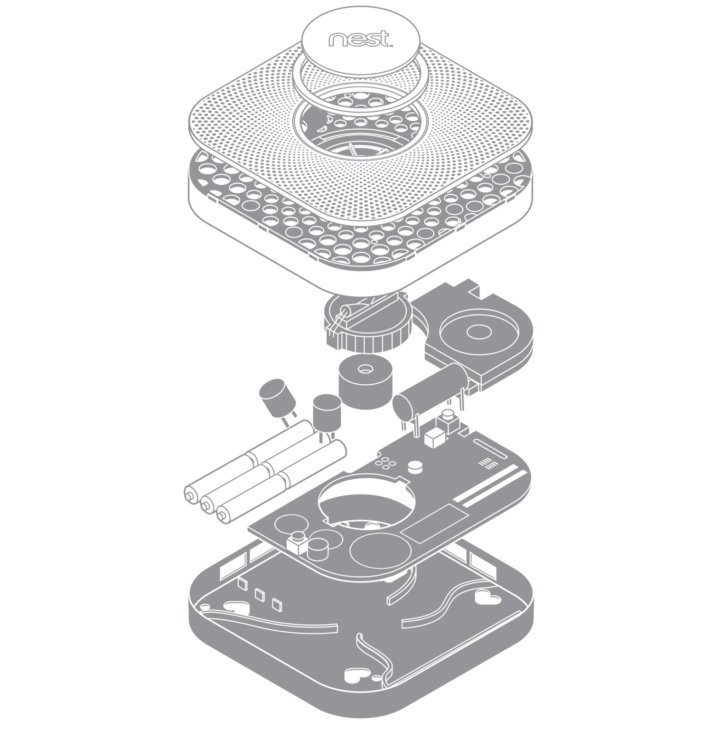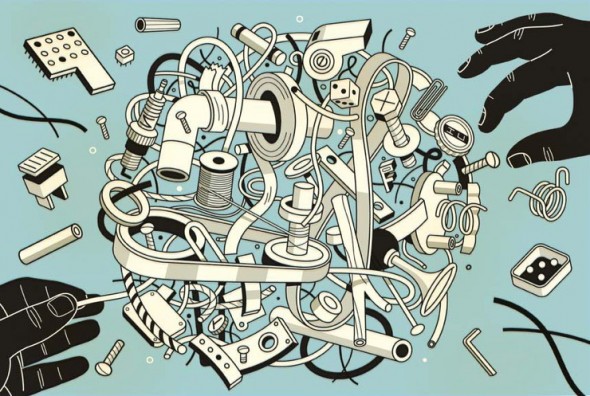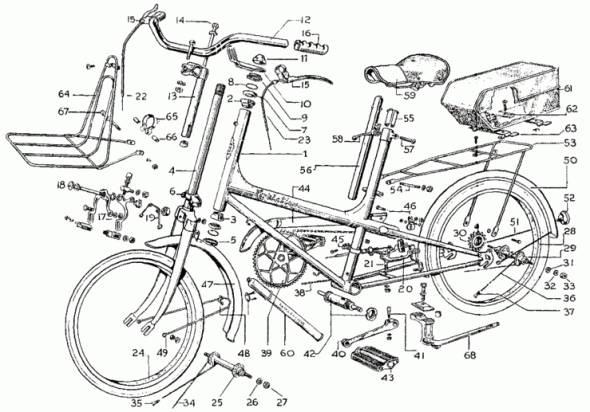YouTube channel Learn Engineering is a great series of videos explaining how everyday objects work. The 3D animations of different gears, motors, coils and fields are clear and really help illustrate the easy-to-understand script.
Machines: How They Work
This series of short videos from the Science Channel reveal the hidden workings of our everyday world with photo-realistic 3D graphics to explode appliances, products and machines into their component parts.
The combination of video footage, CGI, interviews, and of course, overly-dramatic narration really pulls you in and gets you interested in the topic.
Remie Geoffroi
Freelance illustrator Remie Geoffroi creates a wide range of work—from portraits, lifestyle, sports and business editorials to infographics, exploded diagrams, instructional illustrations and architectural drawings. What unites it all is his clean, technical use of vector artwork and a mastery of line quality.
It’s probably this combination of versatility and consistency that keeps art directors calling. Remie has worked with clients including AARP, Sports Illustrated, TIME, ESPN, Men’s Health, Martha Stewart Living and Bon Appétit, and advertising clients including American Airlines, Coca-Cola, McDonald’s, Microsoft and Volkswagen.
How did you get started in illustration?
Drawing was all I ever wanted to do. Through high school I took part time jobs at an animation studio, a screen printer’s art department, etc. I went to college for graphic design because I was pretty hazy on what a career as an illustrator would look like. I ended up being hired as a clip art illustrator right out of college, and set out as a freelancer shortly afterwards.
What is a typical day for you as a freelance illustrator?
I regularly work with magazines (Billboard, ESPN, etc.), and occasionally advertising agencies, Sid Lee, DDB, etc. I recently illustrated “Tools of Titans” the new book from Tim Ferriss, and a book for Gold’s Gym, coming out later this year.
I have a shared studio space where I work from, or I’ll sometimes choose to work out of my home office if the weather is bad or my workload is light.
How do you create your illustrations?
I work almost exclusively in Adobe Illustrator. Many of my illustrations that people have assumed are raster (Photoshop) are actually vector. I like the versatility of being able to tweak the lines. I’ve developed a very streamlined, comfortable process for creating vector artwork. I appreciate being able to revisit files years later to harvest and reuse elements.
You work in a range of styles, how do you choose the style for a particular project?
The assignment usually dictates the style. Art directors usually point to one example or another from my site that they’d like to see. Repeat clients don’t usually request a particular style, as they usually trust where I’ll take a particular project.
What challenges have you faced in your career? What opportunities do you see for the future?
Like most freelancers, workflow can ebb from time to time, and those can be nerve-wracking periods. I’ve been fortunate enough to avoid any true work droughts in my 17 years of freelancing.
I’m optimistic new opportunities will continue to appear. App development wasn’t even a thing a few years ago, and it’s become a major place for illustrators to create and find work.
Magazines were supposed to be dead years ago, and yet they continue. That said, I’ve been sad to see a few fall away recently.
Any tips for illustrators starting their careers?
A successful career as a freelance illustrator is built upon relationships. Recognize that you’re building relationships with your clients, primarily art directors. Be ready and willing to accept their criticism and make changes. Be professional and on time with your work. Be courteous and understand that there are many other illustrators out there, so your attitude can be a big factor in who wants to work with you.
Big thanks to Remie Geoffroi for his time!
MacBook Redesign Video
Yesterday’s post reminded me of this video about the redesign of the Apple MacBook released last year. This one is a bit more informative in tone and has some great visualizations of otherwise invisible features, the pressure-sensitive trackpad, for example.
This really shows the selling power of information.
Smartphone Isometric Illustration Process
Infographic artist Ninian Carter (previously) has shared another step-by-step isometric illustration process, this time of a modular smartphone and its interchangeable internal components.
Check it out at his blog, Graphic Gibbon.
Vic Kulihin
The vector illustrations of Vic Kulihin are fresh, bold and contemporary. So you might be surprised to learn that his freelance career began in 1988. Vic was kind enough to answer a few questions about how the industry has changed in that time and give a few tips on having a long and successful career.
What’s your background? How did you find your way into illustration?
I started out as an engineering major at Rutgers University, but graduated with a degree in art education (long story). After college I worked as a paste-up artist for a small ad agency, which folded not long after I started. I then found a position as a technical illustrator for Bell Laboratories. This was back in the day when we used airbrushes, technical pens, straight edges, French curves and typesetting machines. During my stint there these tools were gradually replaced with Macintosh II desktop computers using Adobe Illustrator 88 software.
After a decade I left Bell Labs to start my own freelance business. The timing was right. I was able to combine my work with being a stay-at-home dad for my baby daughter. At that time I focused on colored pencil illustration, but eventually gravitated back to the Mac and vector art.
Earlier in my career I took classes at Parsons, the School of Visual Arts and the Art Students League of New York to make up for my lack of formal art training. I still take classes periodically, but the beauty of it nowadays is that they are readily available online.
What is your favorite subject matter or type of project?
Although I’ve had the opportunity to draw a great variety of things, I think my favorite subject matter has always involved mechanical devices…tools, machinery, that kind of thing. I enjoy creating assembly instructions, exploded diagrams, cutaways, schematic drawings (I think I’ve always been an engineer at heart).
What’s your process for a typical project?
I start with a thorough discussion of the project with the client: project specs, style, number of iterations of sketches/final art, timeframe, budget, etc. When the project involves a product I ask the client to supply me with reference photographs and, whenever practical, the actual product itself. For projects involving people I will often photograph live models and/or use software like Poser or DAZ.
I currently work on a Mac Pro with a 30” Apple Cinema Display; I also have a Wacom Intuos3 tablet that I use infrequently (oddly enough I feel most comfortable wielding a mouse). Software of choice is Adobe Illustrator.
Tools like Skype and GoToMeeting have allowed me to work closely and “in person” with clients globally, something I never would have envisioned when I first started out.
You market your services in a number of illustration directories. What has been your experience with that?
I find that of all the portfolio sites I use the majority of my work comes from three directories (theispot, Directory of Illustration, Workbook) and the assignments from these have covered the gamut of illustration. The income that results from these projects generally justifies the expenditure for these sites. I also periodically do a direct mailing campaign. Recently I’ve expanded my online visibility and interactions through social media such as Behance, Twitter, Facebook and LinkedIn.
You’ve been illustrating for 27 years, what do you think makes for a long and successful career?
The biggest challenge has been dealing with the “feast or famine” syndrome…drumming up business when things are slow, or trying to deal with the onslaught when things get very busy.
As for the future?… For some years it seemed like photographs and video were “where it’s at”. But I’ve noticed more recently a big increase in the use of illustration across media.
That’s great news for the likes of us!
Inspiration: Todd McLellan
Photographer Todd McLellan takes breathtaking shots of everyday mechanical objects disassembled & painstakingly organized—and then presumably tossed into the air. Take a peak under Projects > Classic Motorcycles while you’re at it!
(via BoingBoing)
I’ve never seen such devotion in a droid before

Linch Pin Droid by Kevin Tong
Illustrator Kevin Tong created this great exploded R2-D2 poster for an ongoing Star Wars Art Print series by Mondo Tees. He did a thorough post on his creative process and even made a time-lapse video showing his technique:
httpvhd://www.youtube.com/watch?v=Ta5TBGzqijk&feature=player_embedded
Linch Pin Droid goes on sale Friday.
Assembly Illustration From Hell
Happy Friday [via Adafruit]
Harry Campbell’s Technical Inspirations
The work of award winning editorial illustrator Harry Campbell is infused with a technical illustration aesthetic. A nod to the highly complex and industrialized world we live in, he makes use of bold structural lineart, axonometric drawing systems, parts explosions, and cutaways to communicate ideas.
For his latest work for The Wall Street Journal, he shares a bit about his process and inspiration:
[…] Just in case anybody is wondering about whether my mechanical objects are traced or taken from other drawings. Generally not, I just start drawing. I do look at reference like vaccum tubes, things like that. During this project I was thinking I need to start gathering a bin of junk to pull from. I do love exploded views of ordinary objects. Here’s one of my favorites.
See more of Mr. Campbell’s work on Drawger or his rep, Gerald & Cullen Rapp.














